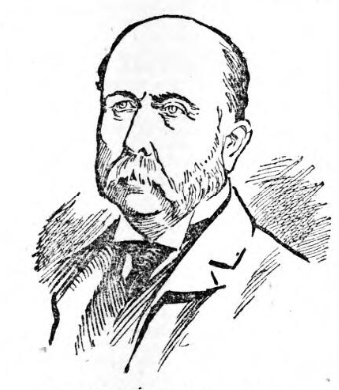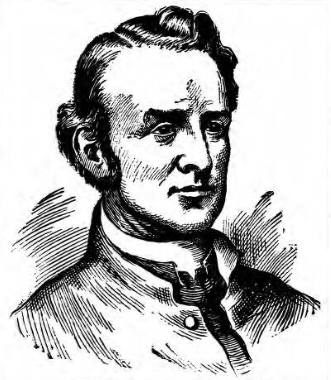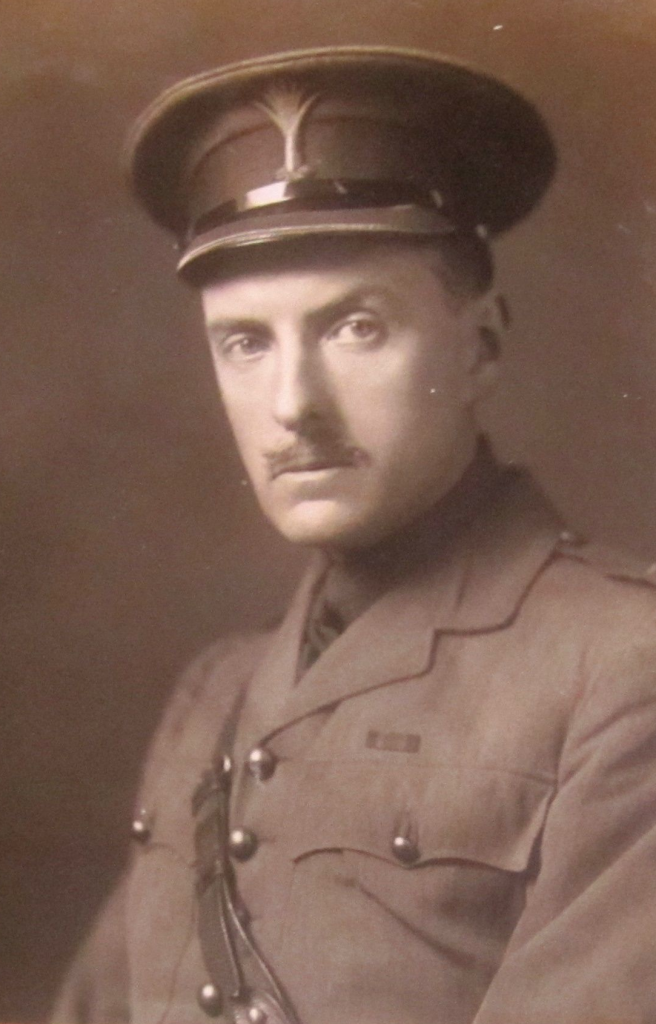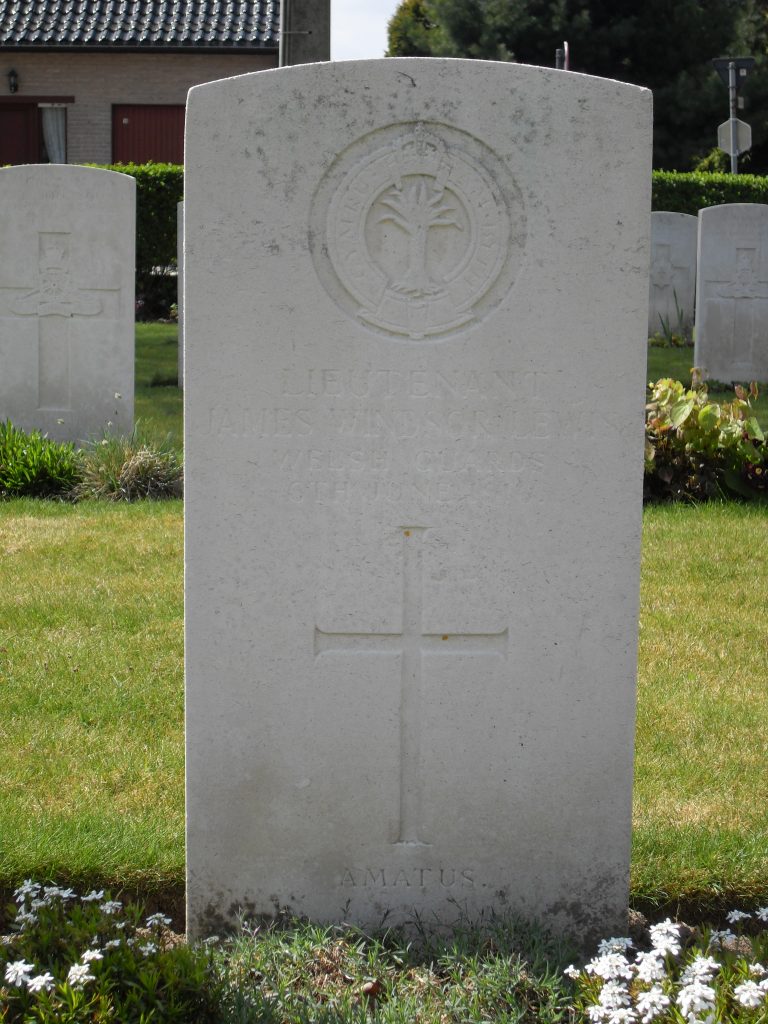Fact file:
Matriculated: 1893
Born: 3 March 1877
Died: 6 June 1916
Regiment: Welsh Guards
Grave/Memorial: Brandhoek Military Cemetery: II.E.2.
Family background
b. 3 March 1877 at Plâs Draw House, Cefnpennar/Llwydcoed, Aberdare, Glamorganshire, as the only son and older child of James Lewis, JP (1829–1901) and Louisa Catherine Lewis (née Edwards) (1845–1921) (m. 1867). At the time of the 1881 and 1891 Censuses the family lived at Plâs Draw House (five servants in 1881; six servants in 1891) but by the time of the 1901 Census and before the death of James Lewis the family had moved to Winterbourne, Painswick Road, Cheltenham, Gloucestershire (four servants); and by the 1911 Census Louisa Catherine had moved to Trefelwy, Mount Road, St Asaph, where her brother was bishop.
[His surname was Lewis and his children were registered as Lewis and married as Lewis, and on official documents he is either Lewis or James Windsor Lewis. However, there are newspaper reports giving his surname as Windsor Lewis (no hyphen), e.g. the report on the funeral of his father-in-law gives his widow as Mrs Windsor Lewis.]
Parents
Lewis’s father was the son of Edward Lewis (b. 1783), one of the owners of the Glamorganshire Canal. James Lewis was described as “the last of the old coalmasters” of the Aberdare Valley. He took over the tenancy of Abernant collieries from his brother-in-law Richard Fothergill (see below) and served as High Sheriff of Glamorgan and Brecknock in 1882. He was also an active and prominent churchman who helped set up St Michael’s Theological College, Aberdare, in 1892: it moved to Llandaff in 1905.
In 1848, James’s paternal aunt Elizabeth (c.1820–1850) became the first wife of Richard Fothergill (1822–1903), ironmaster and the owner of one of the largest conglomerates of ironworks in the Aberdare Valley/Merthyr Tydfil area, and from 1868 to 1880 one of the first two MPs for Merthyr Tydfil (1868–80). Even after Fothergill’s company had crashed in 1875 because of strikes and changes in the production of steel via the Bessemer process, he continued business as a colliery owner and coal merchant.
Lewis’s mother was the daughter of the Reverend William Edwards(1800–68), an Anglican clergyman and Vicar of Llangollen, Denbighshire. George Borrow (1803–81) in his book Wild Wales (1862) describes a visit to the Vicarage in Llangollen, referring to the vicar as a first-rate Greek and Latin scholar. All five of his sons (Lewis’s uncles) went to Jesus College, Oxford, before going into the Church: Reverend Canon Ebenezer Wood Edwards (1831–97), Vicar of Ruabon; Reverend William Joseph Edwards (1833–99), Vicar of Llandow, Glamorgan; the Very Reverend Henry Thomas Edwards (1837–84), appointed Dean of Bangor in 1876, an early proponent of the disestablishment of the Welsh Church, who suffered from depression, and committed suicide while staying with his brother in Ruabon on his way home after consulting a London specialist; Reverend Bickerton Augustus Edwards, Latin scholar and Vicar of Bettws-yn-Rhos, Denbighsire; and the Most Reverend Dr Alfred George Edwards (1848–1937), who was consecrated Bishop of St Asaph in 1889 and opposed the disestablishment of the Welsh Church, but was nevertheless elected the first Archbishop of Wales after the disestablishment of the Welsh Church in 1920.

James Windsor Lewis, MA
(North-Eastern Daily Gazette [Middlesbrough, Teesside]), 13 June 1917, p. 3).
Lewis’s sister was Rachel Elizabeth (1879–1958), later Gregorie after her marriage in 1901]to Charles Gregorie (1862–1951), a mining engineer and colliery manager in South Wales); they had two children. In 1905 James married Charles Gregorie’s sister.
Wife and children
In 1905 Lewis became the husband of Catherine Henrietta Lewis (née Gregorie) (1874–1972), of 67 Cadogan Place, London SW1, and The Court, Crondall, Hampshire. Catherine Henrietta was the eighth child of Major-General Charles Frederick Gregorie, CB (1834–1918), the Colonel of the Royal Irish Regiment, and even before she became James’s wife, she was his sister-in-law since she was the sister of Charles Gregorie (see above).
James and Catherine had three children:
(1) James Charles (later Brigadier, DSO and Bar, MC) (1907–64), who in 1941 married Audrey Olive Harrison (1914–94), the daughter of Lieutenant-Colonel John Fenwick Harrison (1884–1966) and Margaret Olive Harrison (neé Levy-Lawson) (1902–69), the grand-daughter of Colonel William Arnold Webster Levy-Lawson (1864–1943), the 3rd Baron Burnham, and Sibyl Mary Levy-Lawson (née Marshall) (1872–1933; two sons and two daughters; after this marriage was dissolved in 1961, he married in the same year Anne Murray (née Drummond) (1911–85);
(2) Joan Henrietta (1909–99), later Curzon-Howe-Herrick after her marriage in 1930 to Lieutenant-Colonel Assheton Penn Curzon-Howe-Herrick (1898–1959), the son of Admiral the Honourable Sir Assheton Gore Curzon-Howe, KCB, CVO, CMG (1850–1911), a landowner and racehorse trainer; two children;
(3) Jean Mary (1912–2007); later Glerum after her marriage in 1947 to Herman Wilhelm (William) Glerum (1911–2002), the well-known Dutch cricketer); one son.
James Charles became a professional soldier and rose to be the General Officer Commanding the 1st Guards Brigade.
Education and professional life
Lewis attended Bradfield College, Berkshire, from 1890 to 1895, where he became a Prefect (1894). In 1893 he represented Bradfield as one of the Cadet Pair in the rifle-shooting competition for the Ashburton Shield that is held annually over four days at Bisley and is currently open only to teams from Public Schools. He was a Commoner at Magdalen from 1895 to 1898, when he was awarded a 3rd (BA 1898; MA 1906).
He was admitted to the Inner Temple on 14 November 1896 and called to the Bar on 23 April 1902, but he seems never to have practised as a barrister since no business address is recorded. In 1907 he undertook an enquiry for Field-Marshal Lord Roberts (1832–1914) and the National Service League (founded 1902 to promote compulsory military service in Britain) into the Norwegian system of universal military service, and his report, together with one by Colonel Charles Delme-Radcliffe on the Swiss system, was published in 1908 as A Territorial Army in Being: A Practical Study of the Swiss Militia and the Norwegian Militia.
In the by-election of July 1909 and the two general elections of January and December 1910 he stood as Conservative and Unionist candidate for the Cleveland Division of Yorkshire against the prominent left-wing Liberal politician Mr (later Viscount) Herbert Samuel (1870–1963; MP for the Cleveland Division 1902–18), when Samuel was appointed Chancellor of the Duchy of Lancaster. But in December 1910 Lewis lost by 5,343 votes to 6,870. On 15 October 1911 he was adopted as the Conservative and Unionist prospective candidate for the North Somerset Division (1913–1916). He was deeply interested in the housing question and carried out with success an extensive scheme on his property at Llwydcoed, Glamorganshire. A commentator wrote that he “was genuinely desirous of playing the part of a useful citizen, ready, within the opportunities which presented themselves, to make his contribution to the cause of social reform”. And an obituary that appeared in the North-Eastern Daily Gazette on 13 June 1917 summarized his political career as follows:
The honest young Welshman who launched an, alas, too short political career in a constituency notoriously hostile to the cause which he espoused [was] characterized on his part by an earnestness and a real desire to help his country in solving difficult problems which it was impossible not to appreciate. These were at a time when he was quite a novice in politics. He was an imperialist in the truest sense; he believed that the strength of an empire lay in the contentment of the cottage. This was very clear from his views on the housing question. More than once, especially after travels in Canada, he expressed sympathy with a settlement of the Irish question on a Federal basis, and with the aspirations of the working classes he expressed much sympathy. There was no double dealing with Mr Lewis – it was foreign to his nature. Frank, sincere, and straightforward, he was a type of man to win respect for the opinions he expressed, and to command the admiration of all who valued honesty in our politics.
Military and war service
On the outbreak of the Second Boer War in 1899, Lewis joined the 19th Royal (Queen Alexandra’s Own) Hussars (“The Dumpies”) as a Second Lieutenant, where he must have known C.R. McClure, and served in the Transvaal and the Orange River Colony (Queen’s Medal, four clasps). Although he retired from the Regular Army in May 1905, he joined the West Kent Imperial Yeomanry in July of that year (London Gazette, no. 27,815, 11 July 1905, p. 4,811), and became a Lieutenant in the Reserve of Officers on 27 June 1906. He is recorded as having resigned his commission twice, on 25 January 1910 and 18 July 1914; but on the outbreak of war he joined the Reserve Cavalry and was subsequently sent to serve in Egypt with a Regiment that has not been identified. But when the Welsh Guards were formed on 27 February 1915, he transferred to its Reserve of Officers. On 14 August 1915 he was commissioned Lieutenant in the Regiment’s 1st (Regular) Battalion (LG, no. 29,287, 7 September 1915, p. 8,876), and he was with it when it landed at Le Havre on 18 August. Two days later, at St-Omer, the 1st Battalion became part of the 3rd Guards Brigade in the newly formed Guards Division.
During the Battle of Loos, on the afternoon of 26 September, the Battalion took part in the capture of Hill 70, east of Loos between Bois Hugo and Cité St Auguste, losing 183 of its members killed, wounded or missing in the action. After the Battle, the Battalion stayed in the maze of trenches south of Loos, near Vermelles, that led up to and round the fortified German position known as the Hohenzollern Redoubt, and it was here that Lewis and four other replacement officers joined the Battalion on 20 October, with Lewis becoming an officer in 3 Company. Three days later, taking advantage of the successful attack to straighten the front line that had started on 17 October, the Battalion took up position in the newly captured Hohenzollern Redoubt (see F.M. Carver), where, according to its War Diary, the “smell and sights [were] inexpressible” because of the unburied German dead. It alternated its time in the trenches with periods of rest in the village of Allouagne, near Béthune, where, according to the Battalion’s historian, “the regimental soul” was born.
During the autumn of 1915, Lewis acted as Adjutant for a couple of weeks. From 14 November 1915 to 15 February 1916 the reinforced Battalion was re-assigned, this time to the trenches near Laventie, 150–300 yards from the enemy in very wet ground, with breaks in the town of La Gorgue. Here, life was “one long struggle against water”, the front line was little more than a loose system of defence that was held by three Companies and a series of strong-points to the rear, it was very cold, and the Battalion’s positions were overlooked from Aubers Ridge. But in mid-February it moved briefly to Estaires before leaving the area completely. From 17 to 25 February 1916 the Battalion was back at Calais; from 26 February to 5 March it was at Wormhoudt, some seven miles north-west of Poperinghe and just in northern France; and after spending two weeks in a rest area to the west of Poperinghe, it reached Ypres on 16 March, where it was sent almost immediately to the trenches in the Potijze sector. Here it stayed, with breaks behind the line at Vlamertinghe, until mid-May, a relatively quiet period, during which Lewis was on leave beginning on 25 March. On 1 June the Battalion was encamped behind the line, near St Jean de Beizen, and providing large bodies of men for fatigue duties at the front to the east of Ypres. The Battalion War Diary records that between 2 and 4 June, a work detachment of 100 men under Lieutenant J.W. Lewis was sent to the canal bank, near Ypres. On the night of 5/6 June 1916, when the British positions were being shelled persistently, Lewis had just seen his men into their billets near Machine Gun Farm, west of Ypres, and was returning to his own dug-out when a piece of shrapnel hit him, killing him instantly, aged 39. He was buried with full military honours at 15.00 hours on the same afternoon at Brandhoek Military Cemetery, Vlamertinghe (four miles west of Ypres), in Grave II.E.2. He is commemorated in All Saints Church, Crondall, Hampshire, also on the War Memorial at St Asaph, Denbighshire, and on the Llwydcoed War Memorial, Glamorganshire.
A colleague later said: “A quiet conscientious fellow was Windsor Lewis, and with a sense of humour. He had been through the South African War and was a thorough soldier”; “he knew every man and the condition of his family”. The regimental history cites a letter written on 6 June by a brother officer, who pays Lewis the following compliment:
A charming, kind, gentle man, of whom I was very fond. He fussed and worried about his men until he frequently made himself ill, and it was while looking round to see that none of them were exposing themselves that he got hit.
President Warren described him posthumously as: “one of the leading Welshmen of his standing”, who
had already done much both as a soldier and as a civilian, and gave ample promise of yet further services. […] He was a quiet, steady man, with something of the sensitiveness and shyness of his race that are so evident when they play rugby, but won his way and gained ground year by year, and if not specially conspicuous was well known and much esteemed when he left [Magdalen].
He left £130,821 11s 6d.
Bibliography
For the books and archives referred to here in short form, refer to the Slow Dusk Bibliography and Archival Sources.
Printed sources:
[Anon.], ‘Obituary’, The Times, no. 36,402 (14 March 1901), p. 6.
[Anon.], ‘Cleveland Contest: Mr Samuel’s Final Call to the Electors’, The Times, no. 41,033 (9 December 1915), p. 12.
[Anon.], ‘Lieutenant James Windsor Lewis’ [obituary], The Times, no. 41,191 (12 June 1916), p. 8.
[Thomas Herbert Warren], ‘Oxford’s Sacrifice’ [obituary], The Oxford Magazine, 34, no. 23 (16 June 1916), p. 378.
R. McC., ‘Guards Officer Killed: Former Unionist Candidate for Cleveland: Stirring Fights Recalled’ [obituary], North-Eastern Daily Gazette (Middlesbrough, Teesside), [no issue no.], (13 June 1917), p. 3.
Dudley Ward (1920), pp. 43, 47, 50–4, 81.
Rodri Havard Walters, The Economic and Business History of the South Wales Steam Coal Industry, 1840–1914 (1977).
Rose E.B. Coombs, Before Endeavours Fade: A Guide to the Battlefields of the First World War, eighth (revised) printing (Battle of Britain International Ltd: London, 1998), p. 12.
Archival sources:
MCA: Ms. 876 (III), vol. 3.
WO95/1224.







